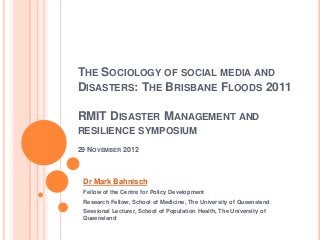
Mark bahnisch rmit sociology of social media and disasters
- 1. THE SOCIOLOGY OF SOCIAL MEDIA AND DISASTERS: THE BRISBANE FLOODS 2011 RMIT DISASTER MANAGEMENT AND RESILIENCE SYMPOSIUM 29 NOVEMBER 2012 Dr Mark Bahnisch Fellow of the Centre for Policy Development Research Fellow, School of Medicine, The University of Queensland Sessional Lecturer, School of Population Health, The University of Queensland
- 2. THE SOCIOLOGY OF SOCIAL MEDIA AND CRISES
- 3. THE SOCIOLOGY OF SOCIAL CRISES Social class most significant predictor of awareness of flood risk (Burningham et al 2008) “Disasters expose our social structure more sharply than other important events.” (Perrow 2007: 3) „Natural‟ disasters are social events (Burgess 2006) Disasters „deritualise‟ (Thornburg et al 2007); posing problems for meaning and action. Communications assist sense giving and communal processes reveal patterns of distributed and collective sense making (Kendra & Wachtendorf 2006) Disasters reveal an imagined community encompassing the interdependence of many smaller networks; this can lead to both resilience/solidarity and discord (Albright 2006) Social networks, repricocity and trust are important elements of „social resilience‟ (Patterson et al 2007) Panic is rare: emergent collective action combined with official response is optimal (Drabek & McEntire 2003)
- 4. IMAG(IN)ING THE FLOODED CITY The city is an imagined space (Bahnisch 2009) Recombinative urbanism (Shane 2007)
- 5. THE SOCIOLOGY OF SOCIAL MEDIA AND OF CRISES Trust: “Trust networks... contain ramified interpersonal connections, consisting mainly of strong ties, within which people set valued, consequential, long-term resources and enterprises at risk to the malfeasance, mistakes, or failures of others.” (Tilly 2007: 81) Repricocity and equality Equipotentiality of contribution (Bruns & Bahnisch 2009) Networks, weak ties and strong ties Connectivity, information and trust Community and culture Community as concentric circles (Bruns 2009) Equality and civic belonging (Wilkinson & Pickett 2009) Social resilience, emergent action and a social media heterotopia?
- 6. RESEARCH QUESTIONS FOR THE FUTURE To what degree could there be a meaningful difference in experience of the floods and social resilience between strong, occasional and non social media users? How were the floods conceptualised by social media users? To what degree did social media effects diffuse more generally, and how? How did distributed processes of „sense making‟ impact on collective responses? What indicators might be valid for comparison between the experience of the Brisbane floods and comparable events elsewhere? How measurable is community resilience? (Sherrieb et al 2010) What can we learn about the levels of and causes of social resilience in Brisbane from this experience? What are the lessons for emergency management, community disaster response and communications?
- 7. THANKS!
- 8. REFERENCES Albright, K. 2006 Review: The Meaning(s) of Community in Post-Disaster New York. Sociological Forum 21(2): 307-314 Bahnisch, M. 2009 Rethinking online hyperlocal urbanisms and creativity. Paper presented at the 'Creative Communities: Sustainable Solutions to Social Inclusion' Conference, 15th-17th April, 2009, Surfers Paradise. Bruns, A. 2009 Social Media: Tools for User-Generated Content: Volume 2 - User Engagement Strategies. Smart Services CRC: Sydney. Bruns, A. & Bahnisch, M. 2009 Social Media: Tools for User-Generated Content: Volume 1 – State of the Art. Smart Services CRC: Sydney. Burgess, A. 2006 The Shock of a Social Disaster in an Age of (Nonsocial) Risk. Space and Culture 9(4): Burningham, K., Fielding, J., Thrush, D. 2008 „It‟ll never happen to me‟: Understanding public awareness of local flood risk. Disasters 32(2): 216-238. Drabek, T. & McEntire, D. 2003 Emergent phenomena and the sociology of disaster: lessons, trends and opportunities from the research literature. Disaster Prevention and Management 12(2): 97-112. Kendra, J. & Wachtendforf, T. 2006 „Community Innovation and Disasters‟ in Rodriguez, H., Quarentelli, E. & Dynes, R. Eds. Handbook of Disaster Research. Springer: New York. Patterson, O., Weil, F., Patel, K. 2009 The Role of Community in Disaster Response: Conceptual Models. Population Research and Policy Review 29(2): 127-141. Perrow, C. 2007 The Next Catastrophe: Reducing our vulnerabilities to natural, industrial and terrorist disasters. Princeton University Press: Princeton NJ. Shane, D. 2005 Recombinant Urbanism: Conceptual modeling in architecture, city design and urban theory. Wiley: Chichester. Sherrieb, K., Norris, F. & Galea, S. 2010 Measuring capacities for community resilience. Social Indicators Research 99(2): 227-247. Thornburg, P., Knottnerus, J., Webb. G. 2007 Disaster and deritualization: A re-interpretation of findings from early disaster research. The Social Science Journal 44(1): 161-166 Tilly, C. 2007 Democracy. Cambridge University Press: New York. Wilkinson, R. & Pickett, K. 2009 The Spirit Level: Why Equality is Better for Everyone. Penguin Books: London.
- 9. ADDENDUM: LARVATUS PRODEO AND THE FLOODS
- 10. Flood thread: January 11 2011 Flood posts Post-flood fundraising
